Hello I am a goodwill guide to the castle
here. If you like, I would like to give you
a tour, it's free of charge. Good, you want
me to guide. How many hours have you got
to stay here, it takes about one and a half
hours to go through with complete explanation.
This hole building is consist of five parts,
from the right, small tower, roofed passage,
main tower, and one, two other wings. We'll
see those buildings in this order, too. The
main tower is about 29m. high and stonewalls
is 3m.
The first three constructions were built
about 400 years ago, it is said sometime
between 1593 and 1594. In those days there
were still civil wars all over Japan. Toyotomi Hideyosi who was the first man to complete ruling
the whole Japan first, chose the Matsumoto
castle as one of the important forts
in the
front line to the east forces, especially
Tokugawa Ieyasu who became the first Syogun later.
Any way Hideyoshi sent one of his good men, Isikawa Kazumasa, to Mastumoto to do the important job. It
is said that he and his son Yasunaga made those three parts.
So, the castle towers were made as impregnable
as possible. If you look at the walls of
the buildings, you notice there are lots
of holes on them, square ones are for shooting
muskets and rectangular ones are for archers.
There are more than 100 of them on the walls
of the whole building. Can you see those places where the walls
jut out, at the center and corners
on the
first floor? They are called isiotoshi or "stone drops".The defenders
would drop stones through these holes
to
the attackers climbing up the walls,
they
also shot guns and arrows through them.
I've
heard that that castles in Europe have
similar
devices, but they used hot oil instead
of
stones. Primitive, but pretty effective
and
merciless I would imagine.
Maybe you are wondering why the constriction
of 400 years old preserved so well. In 1950's,
the castle underwent major renovation, since
the buildings had deteriorated and the main
tower was leaning a bit. At that time, they
took apart the whole building, and each stones
of the stonewalls. They examined every part,
and then remodeled them, fixed them, and
put them back into which they believed to
be their original places. It took 7 years
to complete whole job.
Someone found a piece of decayed wood in
the stonewall of the main tower at the major
renovation. Through the careful examination
they found the fact that the wood tip was
a part of 16 pillars to support the main
tower, but all of them were gone. No wonder
the tower was leaning. Now they have been
replaced with concrete ones. You'll see that
piece of wood, preserved in a glass covered
box in the first floor of the main tower.
Now lets go inside, take off your shoes
and put them in the bag you got. The exit
is different place, so please take it with
you all the way. Inside is dark and each
steps of the stairs are wide, so watch your
steps. Please don't worry about the plastic
bag, it is made of lime and biodegradable.

|
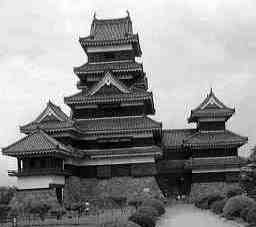
From the right, small tower, roofed passage,main
tower,and two other wings
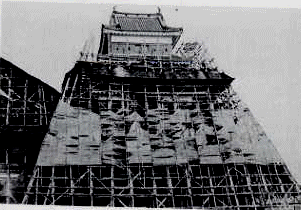
Logs were used as foot steps during the major
renovation
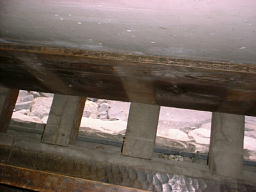
Ishiotoshi from the inside, I wonder they used them
as a toilet
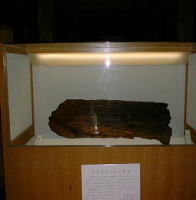
A tip of aged wood found in the stonewall
preserved in the glass box
|
Now we are at the first floor of the small
tower . What's your first impression of inside of the buildings?
Someone says that it is very dark,
and the
other says a lot of pillars there are. Once I was asked where the toilet was. Actually
no one lived in the castle towers,
therefore
no toilets or dining. There were other
places
to live in for the daimyo and his family. I would imagine that watchmen
on duty might used isiotoshis as toilets. No wonder the carps in the moat
are well fed.
Please take a look at the model here, it
was made by some students of technical high
school of Gifu prefecture. Several years
ago they took a school trip here, they were
so much impressed by the beauty of towers
of Matsumoto castle. After the trip, they
made this model and donated it here, so here
it is.
You've probably noticed some round
pillars
are used in the room. It is one of
the distinct
facts of the minor tower, you won't
see any
of them in the rooms of other towers
I have a question here, see the surface
of
the pillars, what kind of tools were
used
to carve the logs like these? Adzes
were
used. The wood is hemlock spruce, fir,
or
Japanese cypress.
Lets go up to the second floor, each steps
of the stairs are pretty wide and very steep,
so please watch your steps.The reason why
they made the stairs like this is easy to
guess, to make the attackers difficult to
climb , right? Students nowadays visiting
the castle on school trip complain much about
it mentioning why they didn't add more steps
to the stairs.
Well you can see the yazama teppozama, holes on the walls, very well from here.
You see, inside of the holes are wider
than
the the outside of them. They say to
make
them easy to aim at and shoot, harder
to
attack from far out. You also see the
thickness
of the wall, it is getting thicker
as the
floor is lower. It is
If you take a look at the window, most
of
windows of the castle buildings are
like
this, please slide it open, it is pretty
heavy isn't it? Muskets those days
needed
at least 2 minutes to reload, so first
get
them ready to shoot, open the window,
shoot,
close the window, and then get the
gun ready
again, and open, then shoot. It is
very primitive
action but quite effective I guess.
Could you come over here, this map was
drawn in Showa era showing us the castle in early 18th
century. There were roughly three kinds
of
castles in Japan according to where
there
were built. One is mountain castles,
they
were built on mountains. Secondly hill
castles
built on hills. And the last kind of
castles
were like Matsumoto castle built in
flat
land, and were easily attacked. So
three
moats were made as defense lines, plus
the Metoba river was used as a forth moat, it used
to flow up north of the castle from
east
to west, but the people who built the
castle
changed the line to the south of the
castle.
It is said the Susuki river, which is now flowing far south of
the castle, was also changed the line.
Inside area of the inner most moat
is called
Honmal, there were castle towers and a big big
house for the daimyo and his family,
but
the house was burn down in January
of 1727
by the fire started in the kitchen.
It was
not rebuilt ever since because of the
finance
situation, I guess. The area between
inner
moat and middle moat is called Ninomaru. There were governmental offices, and the
private residence of the daimyo and his family which was used mainly after
loosing the house in Honmaru, and storages for food and weapons.The area
between middle moat and outer moat
is called
Sannomaru, and there were residence for higher-ranking
samurai, or warriors.The lower-ranking samurais
lived out side of the outer moat surrounding
the castle area mainly up north.Town
people
also lived outer, from south to east
north,
strictly divided by their occupation.
Now let's move on, we are entering
the
second floor of the roofed passage.
This
castle had been ruled by 6 families
and 23
different daimyos ever since it was built. If you look at
the roof tiles in this glass box. Three
of
them on the upper shelf from the right
were
the three family crests out of six
families.
If you look at the roof tile on the
lower
shelf, you'll see some characters on
it,
this fact was also discovered at the
renovation.
These characters tell us the names
and addresses
of the craftsmen and the dates when
and where
the tiles were made. They were carved
in
the tiles while they were still wet,
using
a bamboo spatula or a nail.

|
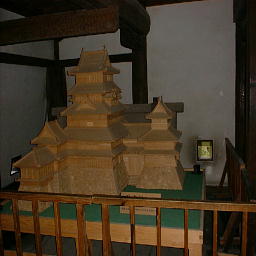
a model made by high school students
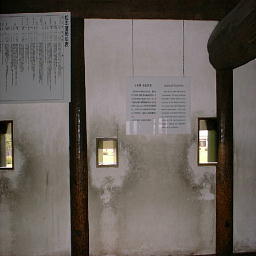
yazama teppozama from the inside
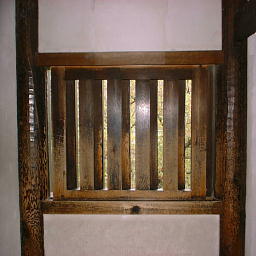
sliding window
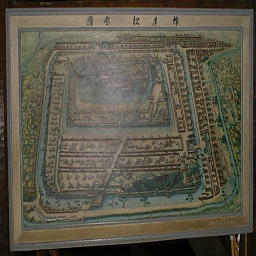
a picture shows the castle in early 18th
century
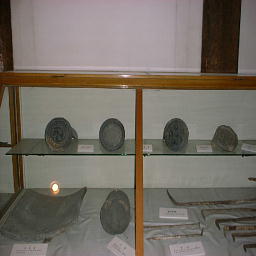
old roof tiles some characters on them
|
